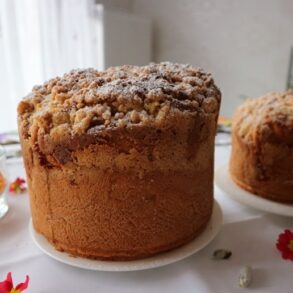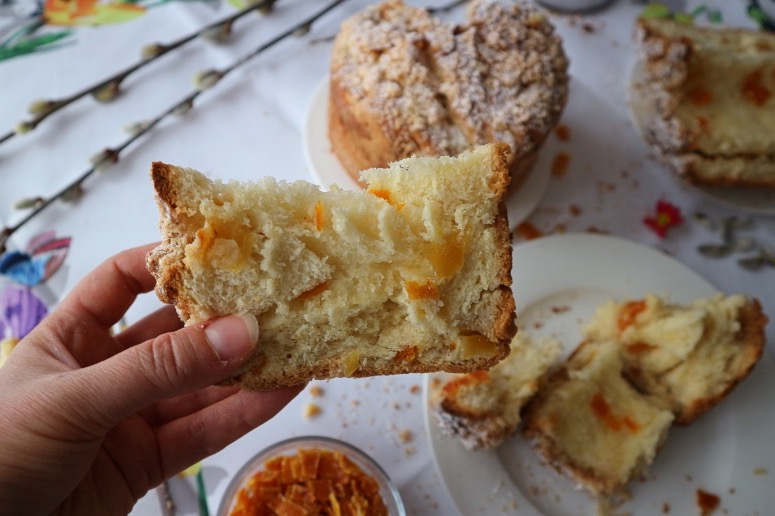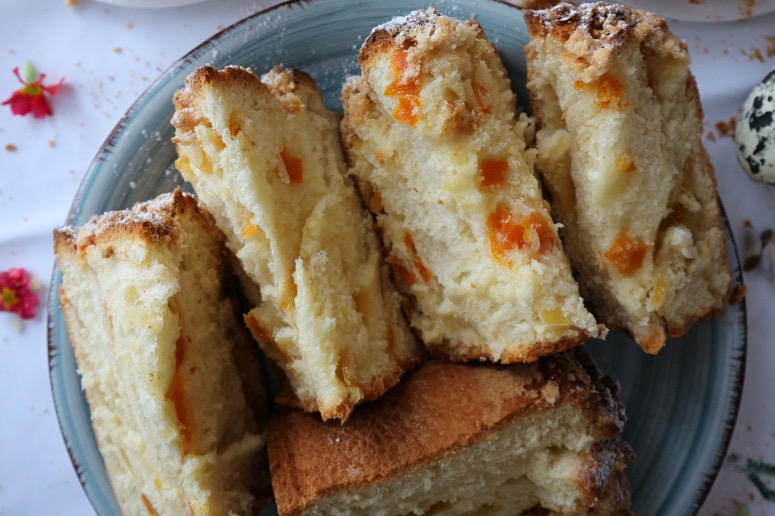Dieser Beitrag ist auch verfügbar auf:
Deutsch
Fluffy puff pastry yeast dough with crunchy crumbles and aromatic candied fruit – this puff pastry kulich tastes irresistibly delicious. It is soft, aromatic and practically melts in your mouth. Sweet crumbles give it a special touch. The recipe for this fancy Russian Easter bread is not difficult at all, so you can bake it at home without much effort. A detailed recipe for the puff pastry kulich with exact quantities and step-by-step instructions can be found here below.

A change from the classic kulich
While in the past people in Russia only baked classic kulich for Easter, people are now experimenting more and more with recipes for Russian Easter bread. For example, I have already baked kulich with curd, kulich with sour cream and kulich made of choux pastry. Maybe you have already made them. This is how this recipe for puff pastry kulich came about. Although kulich is quite different from the traditional Russian Easter bread, it tastes no less delicious than the original and brings variety to your Easter table.
What makes the puff pastry kulich so special?
The uniqueness of this Easter bread is the combination of yeast and puff pastry. How does it work? First of all, a normal yeast dough is prepared – just like for the classic kulich. Then the yeast dough is turned into puff pastry by sprinkling the dough with crumbles and folding it. Of course, depending on taste, candied fruit, raisins, dried fruit or all together in the dough may not be missing. After all, it is a Russian Easter bread. And another special feature of the puff pastry kulich are the crumbles with which it is sprinkled on top, and which taste crispy after baking.
What fruits do I use for the puff pastry kulich?
Just as for the classic Russian Easter bread, you can use any candied fruit, raisins or other dried fruit to your taste for this puff pastry kulich. This time I had refined the dough with homemade candied orange peel and candied lemon peel. Homemade candied fruits simply taste much better than those from the supermarket. In addition, they contain no unnecessary additives. With the candied orange peel and candied lemon peel that I made before, the puff pastry for the kulich became especially aromatic and had a fruity note like from fresh oranges and lemons.
For Easter brunch or as an Easter gift
The puff pastry kulich is of course an ideal Easter pastry. You can serve it among other things to your loved ones for Easter brunch. It tastes delicious on its own. Or spread some butter on the Easter bread – simply delicious. You can also give the puff pastry kulich as a gift – a delicious homemade Easter gift from the kitchen.
This puff pastry kulich is
- juicy,
- fluffy,
- soft,
- aromatic,
- incredibly delicious,
- from a yeast-puff pastry combination,
- with crispy crumbles,
- with homemade fruity candied orange and lemon peel,
- an eye-catcher,
- ideal for Easter brunch,
- perfect gift from the kitchen for Easter,
- easy to bake from common ingredients.
Baking puff pastry kulich: the recipe
The exact quantities and step-by-step instructions for baking the puff pastry kulich at home can be found below in the box recipe.
For the dough you need
- milk,
- egg,
- sugar,
- butter,
- vegetable oil,
- yeast,
- flour,
- a little water to dissolve yeast
- and candied or dried fruit.
Milk must be lukewarm, and the egg must be warm. I had used dry yeast in the recipe, but you can also use fresh yeast if you prefer. For the candied fruit you can use candied orange peel and candied lemon peel.
For the crumble
- cold butter,
- sugar
- and flour
are needed.
I also sprinkled the top of the puff pastry kulich with powdered sugar after baking. But you can prepare a sugar icing, like for the classic Easter bread, and brush it with it on top.
Baking puff pastry kulich: this is how you proceed
- For the dough, dissolve yeast in some lukewarm water. Melt butter together with vegetable oil, add lukewarm milk, sugar and stir. Add egg and then yeast mixture and mix until homogeneous. Add flour and knead into a somewhat sticky dough. Knead the dough for about 8 minutes and let it rise for 1.5 hours.
- For the crumbles, mix flour and sugar, add cold butter and chop into crumbles.
- Roll out the dough into a square, sprinkle the center with the crumbles and fruit, and cover the crumbles with the two sides of the square. Again sprinkle the center with the crumbles and fruit, and cover with the sides to make a long strip. Cut the strip into small squares and wrap the squares around each other, one at a time, to make a thick roll. Place the roll in the baking dish, sprinkle with the last crumbles and let it rise for 40 minutes. Then bake the puff pastry kulich at 180 °C for about 40 – 50 minutes, let cool and sprinkle with powdered sugar. Done!
Baking puff pastry kulich: tips and tricks
- Instead of candied orange peel and lemon peel, you can add raisins or other dried fruit to the dough.
- The puff pastry Easter bread tastes best with homemade candied fruit.
- Instead of dry yeast you can use fresh yeast. For the recipe below you need 21 g of fresh yeast. You have to dissolve the fresh yeast in lukewarm water just like the dry yeast.
- It is important that the water in which the yeast is dissolved and the milk for the dough are lukewarm so that the yeast can work properly. If they are hot or cold, your dough may not be able to rise.
- The egg for the yeast dough must be at room temperature. So get it out of the fridge first if you keep eggs there.
- To give the dough the right consistency, add flour a little at a time. The amount of flour given may vary. The dough should not be too firm and should be a little sticky.
- It is important to knead the dough for about 8 minutes so that it becomes elastic and no longer sticky. This will make the puff pastry Easter bread fluffy and soft at the end.
- The yeast dough should be left to rise in a warm place. To do this, place the mixing bowl with the dough on the second shelf from the bottom in the oven (do not turn on the oven!) and place a bowl of hot water on the bottom of the oven (keep the oven door closed afterwards). This way you will create an ideal climate for the yeast dough – with enough heat and humidity.
- Butter for the crumble must be cold.
- To bake the Russian puff pastry Easter bread, I used a Ø 14 cm and 12 cm high as well as a Ø 16 cm and 13 cm high kulich baking pans, which you can order online, among others.
- The kulich baking pans must be thoroughly greased and dusted with flour (tapping off excess flour) so that you can remove the puff pastry Easter bread from the pans without difficulty after baking.
- Do not fill the baking pans more than halfway with the dough, as the dough will rise quite a bit, especially during baking.
- Depending on the size of your baking pans, the specified baking time can vary greatly. The baking time of my Ø 14 cm puff pastry kulich was 40 minutes, of the Ø 16 cm 50 minutes.
- To prevent the surface of the puff pastry from burning, you can cover it with baking paper as soon as the surface is brown.
- To check if the puff pastry is done, do a stick test. To do this, briefly insert a long toothpick into the center of the Easter bread and see if it stays clean after you pull it out.
- Instead of dusting the puff pastry kulich with powdered sugar, you can coat it with sugar icing like the classic kulich.
You should store the puff pastry Easter bread in an airtight container so that it does not dry out. It can be kept for about 5 days. - Have you baked the puff pastry kulich according to this recipe? I’m looking forward to your results, your star rating and your comment on the recipe below about how you liked and succeeded with the Easter bread.

Puff pastry kulich with crumble
Equipment
- Ø 14 cm and Ø 16 cm large kulich baking pans
Ingredients
for the dough
- 200 ml milk (lukewarm)
- 40 g butter
- 70 g sugar
- 1 egg (room temperature)
- 30 ml vegetable oil
- 50 ml water (lukewarm)
- 50 g (homemade) candied orange peel
- 50 g (homemade) candied lemon peel
- 1/2 tsp salt
- 7 g dry yeast
- approx. 500 g flour
- butter for greasing the baking forms
- flour for dusting the baking forms
- flour for the work surface
for the crumble
- 100 g butter (cold)
- 150 g sugar
- 120 g flour
for dusting
- powdered sugar
Instructions
Preparation of the dough
- Dissolve dry yeast in lukewarm water and let it rest while you prepare the rest of the ingredients.
- Melt butter together with vegetable oil, add lukewarm milk, sugar and salt and stir until sugar and salt are dissolved.
- Add egg and mix until homogeneous.
- Add yeast dissolved in water and mix again.
- Add flour in portions and knead it into a soft, somewhat sticky dough. Then knead the dough for about 8 minutes, cover the mixing bowl with the dough and let it rise in a warm place for 1.5 hours.
Preparation of the crumble
- Mix flour and sugar.
- Add cold butter cut into small pieces and finely chop it into crumbles. Put the bowl with the crumbles in a cold place for the time being, until you need them.
Preparation of the puff pastry kulichs
- Dust the work surface with flour, knead the yeast dough briefly and roll it out thinly into a square.
- Sprinkle half of the crumbles and half of the candied orange and lemon peel over the entire length of the square. Fold the two sides of the square toward the center so they meet in the middle and cover the crumbles, and roll out the dough just a bit so the sides stick together.
- Sprinkle the center of the square, which is now narrower, again with half of the leftover crumbles and half of the leftover candied orange peel and candied lemon peel. Again, fold the two sides of the square toward the center so that they meet in the middle and cover the crumbles, and roll the dough out a bit more so that the sides stick together. This will now give you a long strip of dough filled with crumbles and candied fruit.
- Now cut the dough strip crosswise into several small squares, the width of which is slightly smaller than the height of the baking pan.
- Grease both baking pans with butter and dust them with flour, tapping off the excess flour. Roll up one of the squares into a small roll. Wrap the other squares around the roll, one after the other, until you get a thick roll that is slightly smaller in diameter than the baking pan. Place the roll in the baking pan and sprinkle the top with crumbles. Repeat the same with the remaining squares, place the second roll in the second baking dish and sprinkle with the last crumbles. Let the two puff pastry kulichs rise in the baking dishes in a warm place for 40 minutes.
- Bake the puff pastry Easter bread in a preheated oven at 180 °C on the second rack from the bottom for about 40 - 50 minutes (For this, follow the detailed tips and tricks for baking puff pastry Easter bread here at the top of the post). Let it cool a bit in the baking pans, then take it out, let it cool completely and dust the top with powdered sugar.
Notes
- Instead of candied orange peel and lemon peel go raisins or other dried fruit.
- Fresh yeast can be used instead of dry yeast. For the recipe then 21 g of it are needed.
- The water and milk for the dough must be lukewarm, and the egg must be as warm as room temperature.
- Add flour to the dough in portions so that it does not become too firm.
- Be sure to knead the dough sufficiently.
- Thoroughly grease and flour the kulich baking pans so that the puff pastry Easter bread can be removed from the pans without difficulty after baking.
- Depending on the size of the baking molds, the specified baking time may vary significantly.
- To check if the puff pastry kulich is done baking, do a chopstick test.
- Note the detailed tips and tricks for baking the puff pastry kulich at the top of the post.



